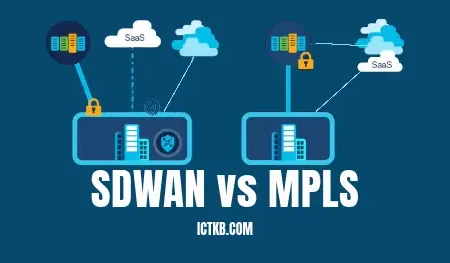SD-WAN (Software-Defined Wide Area Network) and MPLS (Multiprotocol Label Switching) are both types of networking technology used to connect remote networks, but they have some key differences.
Multiprotocol Label Switching (MPLS) is a technology used to route network traffic using a label-switched-path network model. An MPLS network works to increase speed and control the flow of data packets along pre-defined network paths using specialized hardware routers. SD-WAN on the other hand, uses a software defined approach, instead of hardware, as an overlay to connect multiple LANs. As a result, SD-WAN does not require specialised routers; instead, SD-WAN steers traffic via standard internet connections to perform optimally and align with business requirements. SD WAN offers application aware routing to route traffic across the network infrastructure. SD WAN providers can enable direct traffic between the end user in branch offices and cloud applications hosted in the enterprise data centre. Some customers choose SD WAN over private MPLS to keep internet traffic flowing across multiple locations due to its ability to leverage software defined security as well as additional network functions.
Pre-defined policies that reflect modern working patterns and environments make SD-WAN ideal for distributed networks that require intelligent traffic analysis to prioritise critical business application use.
SD-WAN can utilize MPLS as a networking method to provide a hybrid solution if required.
SD WAN vs MPLS Pros and Cons
| MPLS | SD-WAN | |
| Privacy | Connections provided by physical MPLS circuits are over a private, dedicated network. As a result, customers are isolated from one another. | Traffic is steered over the public internet, which impacts privacy. However, a private layer overlay over any network traffic type can mitigate privacy issues. |
| Security | MPLS traffic is not typically encrypted. However, MPLS traffic is based on labels, which act to isolate multiple customers. | To provide robust security, SD-WAN should add a security overlay to provide a secure connection, and all traffic flowing across the network should be encrypted during transit. |
| Hardware requirements | MPLS services require specialised routers to forward packets. | SD-WAN can run using any network hardware. |
| Bandwidth limits | MPLS bandwidth is configuration dependent. Limit on how much capacity can be provisioned over any MPLS connection at any time. | Highly flexible in terms of bandwidth by combining multiple connections and using software to identify and utilise fastest connectivity. |
| QoS (Quality of Service) and QoE (Quality of Experience) | QoS is used to set minimum standards for network performance. | Extends QoS to include QoE to focus on user experience by applying intelligent analysis and traffic prioritisation. |
| Latency and Jitter SLAs | Reliability and performance are backed by end-to-end SLAs. | One key benefit of SD-WAN solutions are that they are highly configurable which enables more granular performance and traffic prioritisation options for routing traffic. This optimises the use of apps such as VOIP. SLAs are less likely to be needed as internet robustness and scalability improvements. |
| Cloud support | Cloud connectivity is complicated via backhauling traffic to a hub or data center. | It is easier than MPLS, with direct support for multiple cloud strategies, so it reduces latency. |
| Traffic steering policies | Limited, may require add-on appliances for control. | Dynamic capability and facilitates real-time traffic steering via policies (including optimising traffic via MPLS). |
| Packet loss | An MPLS network offers more granular control than an SD-WAN architecture; packets always follow the defined path. | In a SD WAN solution, depending on how traffic is routed, some packets could be lost. |
| Reporting capability | Reporting is generally more static and focused on QoS. | Reporting is centralized and gives broad visibility into network performance and QoE. |
| Management and administration | Policy changes are performed on a per-router basis.Upgrades, such as adding a new node, must be carried out by the same vendor. | Zero-touch provisioning (ZTP) to facilitate centralized management. Network provider agnostic. Policy changes can be done centrally and rolled out to all sites simultaneously. |
| Time to deploy | It can be lengthy, and MPLS circuits must be provisioned individually. | Speedier than MPLS circuits, with many full implementations of SD-WAN solutions taking much less than three months. |



